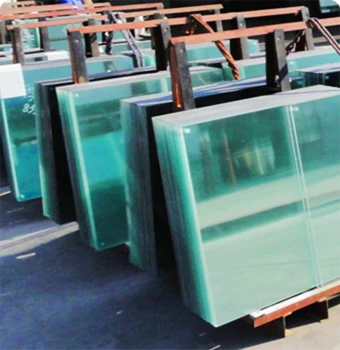The Advantages and Applications of Tempered Glass
Tempered glass, also known as toughened glass, has become a material of choice in various industries due to its strength, safety features, and aesthetic qualities. It is produced through a process of extreme heating and rapid cooling, which increases its strength compared to ordinary glass. This article explores the advantages and diverse applications of tempered glass, highlighting why it is an essential material in modern construction and design.
What is Tempered Glass?
Tempered glass is engineered to be much stronger than standard glass. The process of tempering involves uniformly heating the glass to over 600 degrees Celsius and then rapidly cooling it. This thermal treatment alters the glass's internal structure, creating a state of compressive stress on the surface and tensile stress within. As a result, tempered glass is approximately four to five times stronger than its untreated counterpart.
Safety Features
One of the primary advantages of tempered glass is its safety characteristics. In the event of breakage, instead of shattering into sharp shards that can cause injury, tempered glass fractures into small, blunt pieces. This feature significantly reduces the risk of injury and makes it an ideal choice for environments where safety is a concern. For instance, it is commonly used in shower doors, glass railings, and building facades.
Furthermore, tempered glass is designed to withstand high impacts and extreme temperatures, making it suitable for areas with fluctuating weather conditions and structural demands. It is often used in commercial buildings, high-rise constructions, and residential properties where durability and safety are paramount.
Energy Efficiency
In addition to safety, tempered glass offers excellent energy efficiency. It can be treated with various coatings to improve thermal insulation and reduce heat transfer. This feature is particularly beneficial in energy-efficient buildings, where minimizing energy consumption is a priority. Tempered glass can help maintain a consistent indoor temperature, potentially lowering heating and cooling costs.
tempered glass
Moreover, the use of tempered glass contributes to sustainability in construction. By optimizing natural light and reducing reliance on artificial lighting during the day, buildings can further decrease their carbon footprint. This alignment with environmentally friendly practices has led to its increasing popularity in modern architectural design.
Design Versatility
Tempered glass is highly versatile, offering a sleek and modern aesthetic that enhances the visual appeal of any space. It can be produced in various thicknesses, colors, and finishes, allowing architects and designers to incorporate it creatively into their projects. From floor-to-ceiling windows to glass partitions and balustrades, tempered glass can seamlessly blend functionality with style.
The ability to customize tempered glass makes it suitable for both residential and commercial applications. Whether for a luxury home, an office building, or a retail space, tempered glass can create open, airy environments that promote a sense of spaciousness.
Applications in Various Industries
The applications of tempered glass are vast and varied. In the construction industry, it is commonly used for windows, doors, skylights, and curtain walls. The automotive industry also relies heavily on tempered glass for windshields and side windows due to its impact resistance and safety benefits.
In the realm of furniture design, tempered glass is a popular choice for tables, shelves, and cabinets. Its strength ensures durability while maintaining an elegant appearance that complements a range of interior styles. Additionally, it is widely used in appliances, such as oven doors, due to its ability to withstand high temperatures without compromising safety.
Conclusion
In summary, tempered glass is a remarkable material that combines strength, safety, and aesthetic appeal. Its applications span across various industries, making it a vital component in many modern designs. As architects, builders, and designers continue to seek innovative solutions for safety and sustainability, tempered glass is likely to remain a popular choice for years to come. Whether enhancing residential spaces or sophisticated commercial projects, the benefits of tempered glass are undeniable, showcasing its indispensable role in contemporary architecture and design.
 Afrikaans
Afrikaans  Albanian
Albanian  Amharic
Amharic  Arabic
Arabic  Armenian
Armenian  Azerbaijani
Azerbaijani  Basque
Basque  Belarusian
Belarusian  Bengali
Bengali  Bosnian
Bosnian  Bulgarian
Bulgarian  Catalan
Catalan  Cebuano
Cebuano  Corsican
Corsican  Croatian
Croatian  Czech
Czech  Danish
Danish  Dutch
Dutch  English
English  Esperanto
Esperanto  Estonian
Estonian  Finnish
Finnish  French
French  Frisian
Frisian  Galician
Galician  Georgian
Georgian  German
German  Greek
Greek  Gujarati
Gujarati  Haitian Creole
Haitian Creole  hausa
hausa  hawaiian
hawaiian  Hebrew
Hebrew  Hindi
Hindi  Miao
Miao  Hungarian
Hungarian  Icelandic
Icelandic  igbo
igbo  Indonesian
Indonesian  irish
irish  Italian
Italian  Japanese
Japanese  Javanese
Javanese  Kannada
Kannada  kazakh
kazakh  Khmer
Khmer  Rwandese
Rwandese  Korean
Korean  Kurdish
Kurdish  Kyrgyz
Kyrgyz  Lao
Lao  Latin
Latin  Latvian
Latvian  Lithuanian
Lithuanian  Luxembourgish
Luxembourgish  Macedonian
Macedonian  Malgashi
Malgashi  Malay
Malay  Malayalam
Malayalam  Maltese
Maltese  Maori
Maori  Marathi
Marathi  Mongolian
Mongolian  Myanmar
Myanmar  Nepali
Nepali  Norwegian
Norwegian  Norwegian
Norwegian  Occitan
Occitan  Pashto
Pashto  Persian
Persian  Polish
Polish  Portuguese
Portuguese  Punjabi
Punjabi  Romanian
Romanian  Russian
Russian  Samoan
Samoan  Scottish Gaelic
Scottish Gaelic  Serbian
Serbian  Sesotho
Sesotho  Shona
Shona  Sindhi
Sindhi  Sinhala
Sinhala  Slovak
Slovak  Slovenian
Slovenian  Somali
Somali  Spanish
Spanish  Sundanese
Sundanese  Swahili
Swahili  Swedish
Swedish  Tagalog
Tagalog  Tajik
Tajik  Tamil
Tamil  Tatar
Tatar  Telugu
Telugu  Thai
Thai  Turkish
Turkish  Turkmen
Turkmen  Ukrainian
Ukrainian  Urdu
Urdu  Uighur
Uighur  Uzbek
Uzbek  Vietnamese
Vietnamese  Welsh
Welsh  Bantu
Bantu  Yiddish
Yiddish  Yoruba
Yoruba  Zulu
Zulu 

